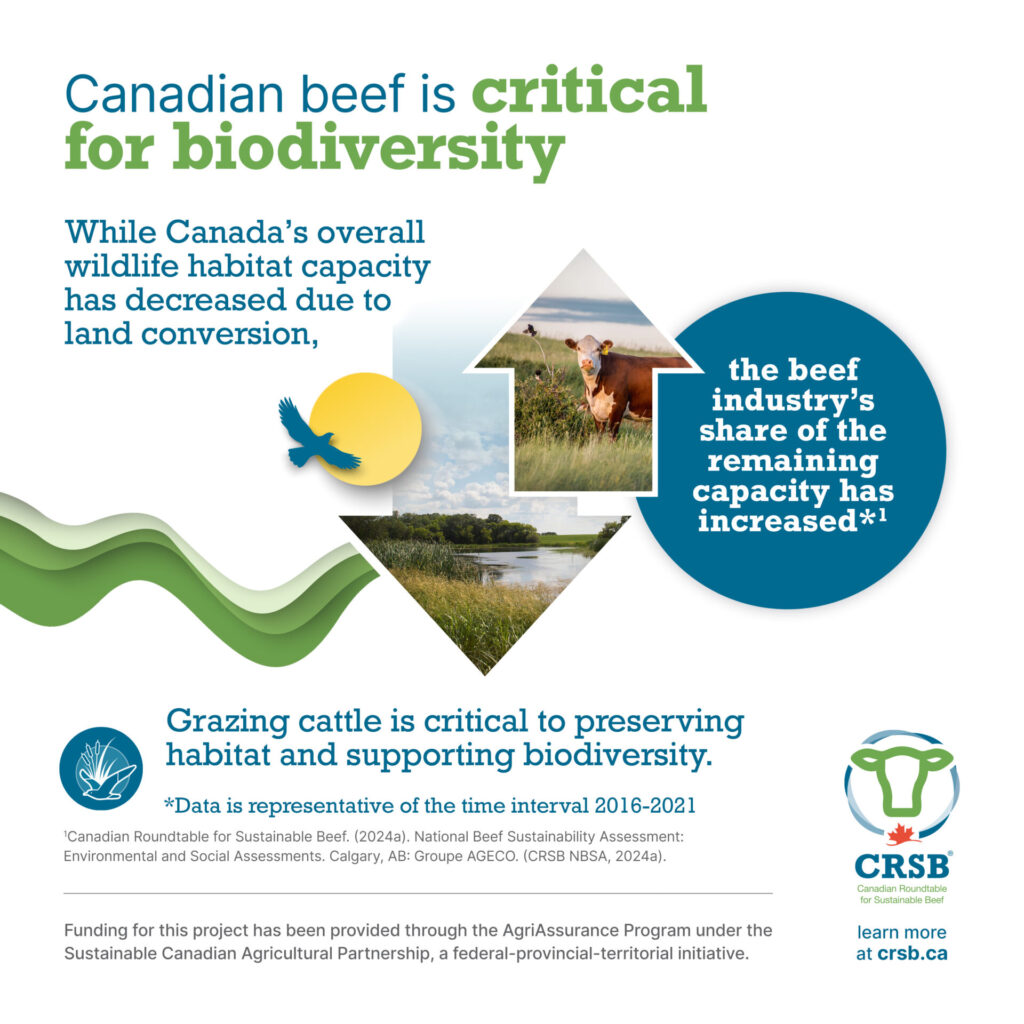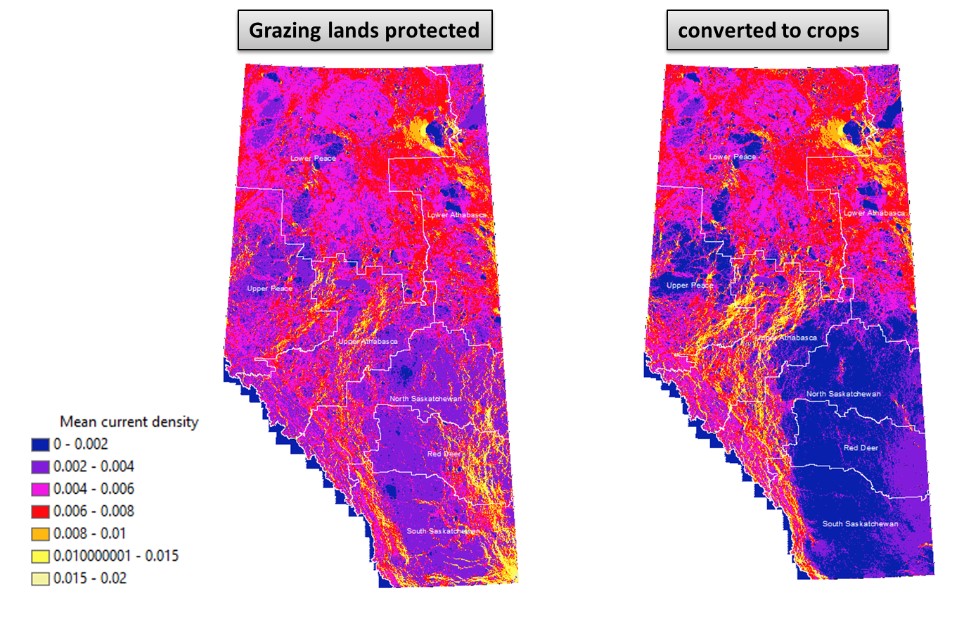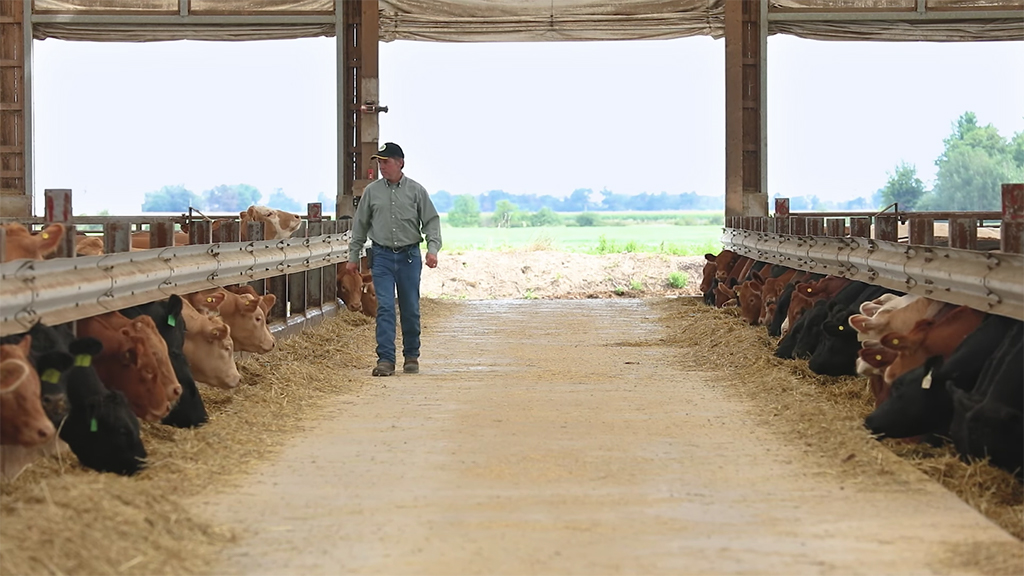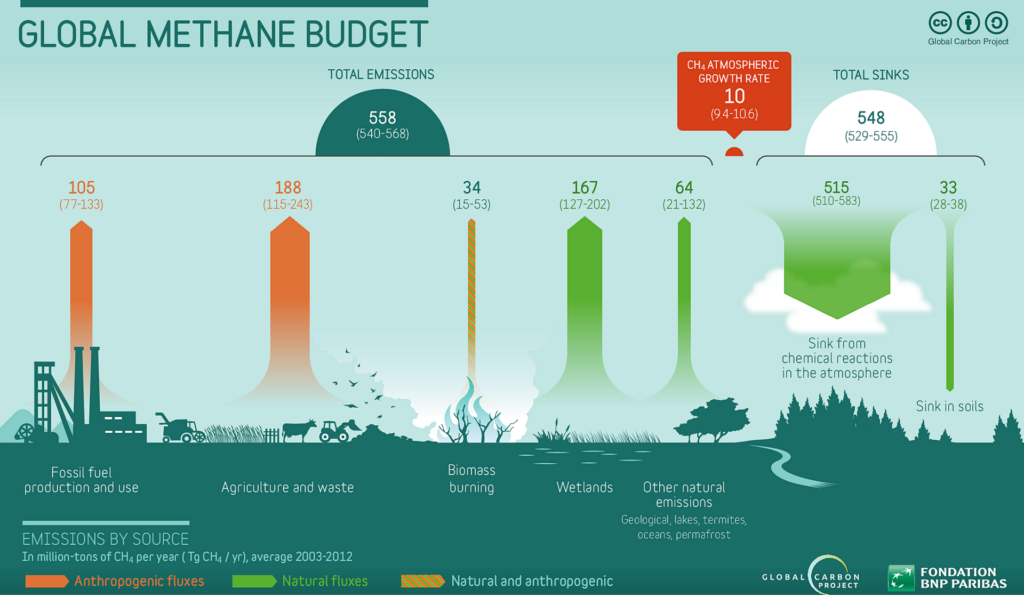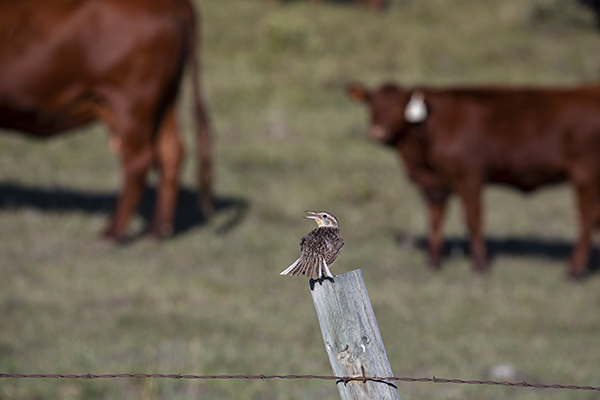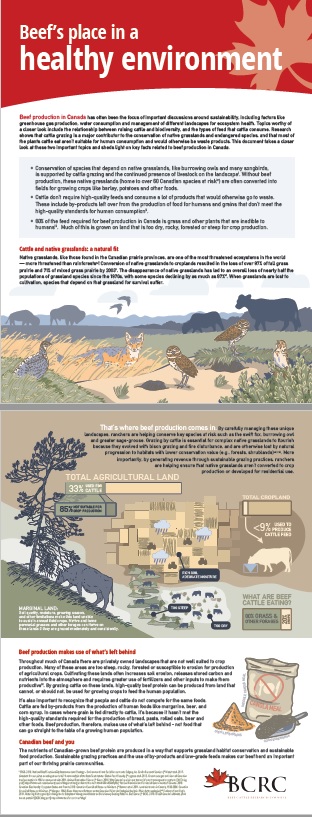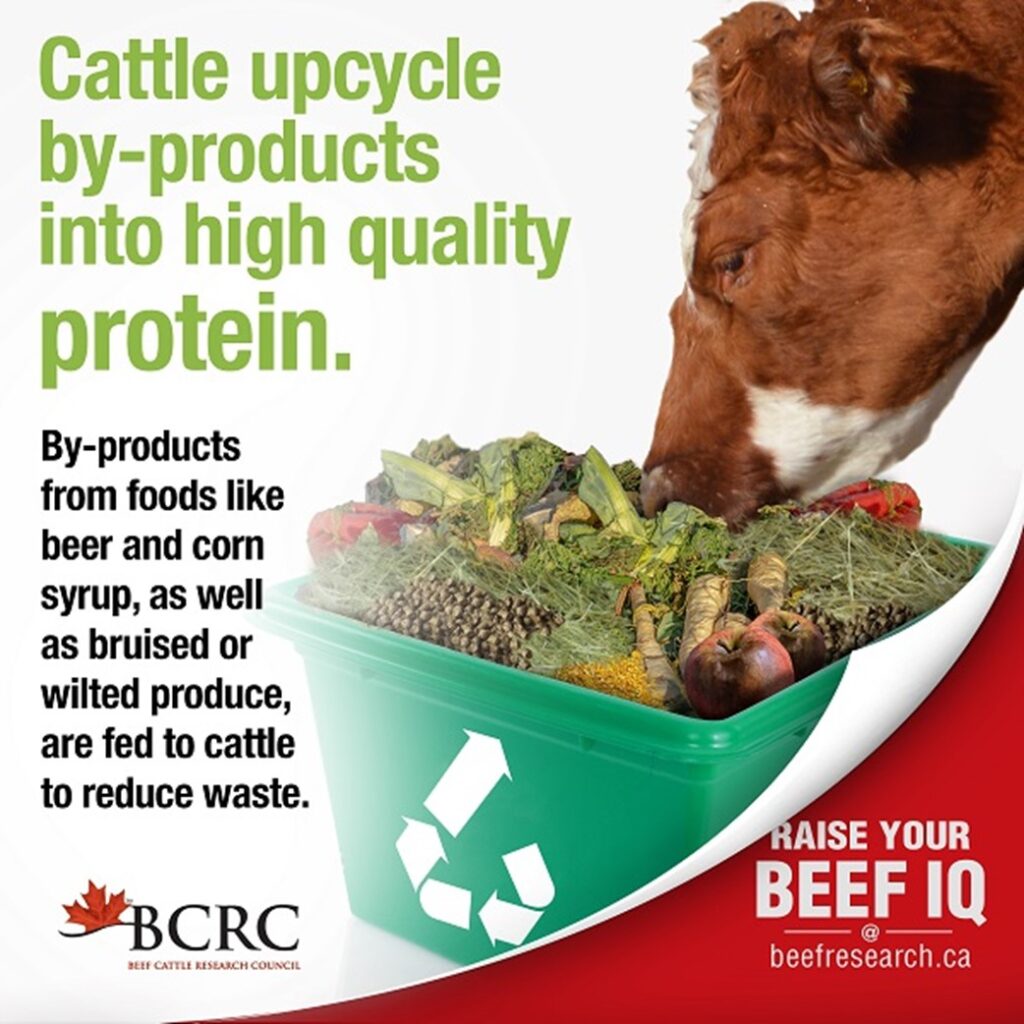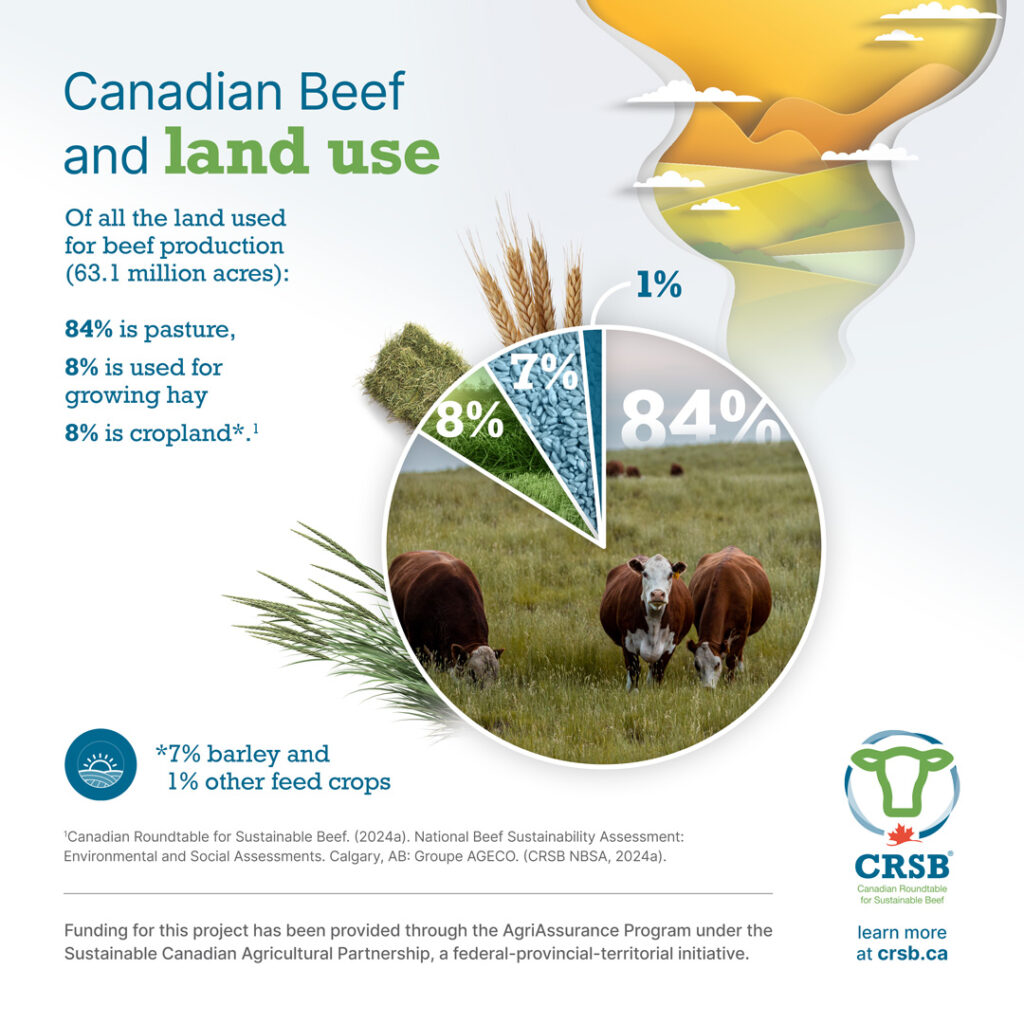Grazing cattle are an integral part of the grassland ecosystem and play an important role in nutrient recycling. Pasture lands are important stores of carbon and provide habitat to many species at risk as well as preservation of wetlands that otherwise may be subject to cultivation. Production of cattle in feedlots lowers the carbon footprint of beef and increases the efficiency of beef production. As with any food production system, there is an environmental footprint associated with beef production.
| Key Points |
|---|
| The efficiency and environmental footprint of beef production in Canada have improved significantly in the last 30 years. Researchers at the University of Manitoba and Agriculture and Agri-Food Canada (AAFC) Lethbridge found that producing each unit of Canadian beef in 2011 compared to 1981:
– used 17% less water, 1 – required 29% less breeding stock, 27% fewer harvested cattle and 24% less land, – reduced greenhouse gas emissions by 15%2 and ammonia emissions by 20%3. |
| Grasslands where beef cattle graze represent an important storage of carbon and may contain up to 200 tonnes of carbon per hectare. Carbon storage can be increased if cropland is planted back to perennial pasture. |
| Grazing ruminants are a natural component of grasslands and play a critical role in the recycling of nutrients. These grasslands also protect endangered and threatened species within these ecosystems. |
| The water that is used in beef production does not disappear; eventually the water will cycle back through the system to be used again. Cattle production can also contribute to the conservation of wetlands, which serve as an important habitat for aquatic birds and mammals. |
| The greenhouse gas emissions associated with beef cattle production can be mitigated by adjusting diets to improve production efficiency (reproduction efficiency, weaning weight and carcass weight). |
| Balanced diets, frequent cleaning and drainage of pens, and proper manure management can help improve nutrient use efficiency, air quality and animal health in feedlots. Areas adjacent to intensive feedlot operations need to implement rotational cropping systems or increase manure transport distances to slow the rate of nutrient accumulation in soils. |
| Use of productivity enhancing technologies (PETs) is an effective strategy to produce more pounds of beef in a shorter period of time, use less feed and reduce the impact on the environment. |
| Synthetic hormones pose minimal risk to the environment, which can be even further mitigated by proper runoff and manure management. |
| Most of the plants that cattle eat and convert into nutrient-dense meat aren’t edible by humans. In North America, grains that fail to make the grade for human consumption represent a significant proportion of the diets of feedlot cattle and contribute to the efficiency of this production system. |
| Cattle producers utilize many grazing management techniques, participate in training such as the Verified Beef Production Plus program, and follow sound, practical research to enhance land use, conservation and management of resources. |
Video: What Beef Producers Need to Know About the Environmental Footprint of the Cattle Industry:
The beef environmental footprint has implications for greenhouse gas emissions, nutrient cycling, water and air quality, carbon stores and preservation of grassland ecosystems. The complexity of these agro-ecosystems has made it difficult to evaluate and compare overall production system sustainability based on multiple environmental indicators. Some components of the footprint such as the production of greenhouse gases are unavoidable as they are produced by plants and animals.
Research shows that the beef cattle industry has made significant improvements in efficiency over time. A research project at the University of Manitoba and Agriculture and Agri-Food Canada (AAFC) Lethbridge, which was partially funded by beef producers through the Beef Science Cluster, found that Canada produced 32% more beef in 2011 than in 1981. Much of this was due to higher carcass weights. Producing the same amount of beef in 2011 required 29% less breeding stock, 27% fewer slaughter cattle and 24% less land, produced 15% less greenhouse gases1,2, and required 17% less water1,2 than in 1981.
Reductions in the beef industry’s environmental footprint have largely come through the use of best management practices and technologies leading to improve production efficiencies. Optimizing nutrition has helped to improve growth and reproductive performance. When more females get pregnant and successfully wean a calf, fewer heifers need to be retained as replacements, so the breeding herd is smaller and there are less cows to produce greenhouse gas emissions. On the feedlot side, heifer carcass weight has increased due to the use of growth promotants. Improvements in feed crop yields mean that a smaller land area is needed to produce the same amount of feed.
Many of the same things that improve productivity on the farm, ranch or feedlot also contribute to a smaller environmental footprint for the beef industry.
Carbon Sequestration in Seeded and Native Grasslands
Over the last century, the majority of prairie grasslands were plowed for crop production with less than 20% of this ecosystem remaining intact. Native grasslands represent an important storage of carbon and may contain up to 200 tonnes of carbon per hectare. Much of this carbon is stored in the roots of grasses and shrubs, explaining why so much more carbon is released by plowing as compared to that released by natural fire.
Carbon storage can be rebuilt if cropland is planted back to perennial pasture, with sequestration initially occurring rapidly and gradually plateauing over a 20-to-25 year period. Once steady state is reached, carbon sequestration is balanced with carbon emissions. In fact, models have shown that if beef cattle are switched from a grain- to perennial forages-based production system, and the forage associated from this transition is derived from newly seeded cropland, the entire beef production cycle becomes a net sink of carbon. However, overgrazing or drought can increase carbon losses.
The ability to further sequester additional carbon in properly managed grasslands is uncertain, but levels may increase further as atmospheric levels of carbon dioxide continue to rise. However, it is clear that any increased sequestration as a result of increases in atmospheric carbon dioxide will not be sufficient to offset ongoing emissions related to the burning of fossil fuels.
Preservation of Grassland Ecosystems

Grazing ruminants are a natural component of grasslands and play a critical role in the recycling of nutrients within these ecosystems. Grasslands are richly biodiverse and are home to many of Canada’s most endangered or threatened species (e.g., burrowing owl, black footed ferret, swift fox, prairie chicken). In a study conducted by researchers at Agriculture and Agri-Food Canada (AAFC) Lethbridge and the University of Manitoba, funded in part by beef farmers through the Beef Science Cluster project, researchers found that beef production can positively impact biodiversity. Although land use associated with the feedlot sector were high in terms of the impact on plants, soil mites, mosses and lichens, the effect on birds and mammals was much less. In fact, is was discovered that the cow-calf sector has a favourable effect on bird populations, and the pasture backgrounding sector positively impacts moss populations. The cow-calf and pasture backgrounding sectors were found to have the least impact, but it is important to note that the impacts with the feedlot sector mainly reflect the use of annual crops for feed production. Therefore, this impact would be present whether these crops were used for livestock feed or for human food consumption.
Plant communities depend on grazing for removal of aftermath, the distribution of seeds and the provision of open niches that can increase sward biodiversity. In addition, establishment of perennial forages reduces the disturbance of prairie bird habitats of and, if near surface water, provides nesting sites for ducks and geese. In many instances, landowners control access to these rangelands, preventing the damage that is readily evident in areas where off road recreational vehicles and other activities have degraded grassland habitat.
Another study funded by the the Canadian Beef Cattle Check-Off off showed that if grasslands are converted into crop land, not only is wildlife habitat disturbed but that it would have major effects on wildlife corridors.
Beef Cattle and Greenhouse Gas Emissions
Nearly every living organism, including plants, produces greenhouse gases. Cattle generate more than other livestock because rumen bacteria produce methane as they digest feed. Additional greenhouse gases come from manure (methane and nitrous oxide) and fossil fuel use on farms (carbon dioxide).
In 2006, the United Nation’s Food and Agriculture Organization of the United Nations (FAO) released a report called “Livestock’s Long Shadow” which greatly misrepresented the amount of emissions produced in raising beef cattle. A more balanced FAO report named “Tackling Climate Change Through Livestock” came out in 2013. This less publicized report found that producing a kilogram of beef in Latin America, India or China generates twice the methane as in North America, Europe or Australia.
A 2015 Beef Science Cluster funded project looked at the change in the Canadian beef industry environmental footprint between 1981 and 2011. Researchers showed that changes in reproductive rate, feed and forage crop yields, growth rates, carcass weights, etc. impact how much feed and land is needed to produce a kilogram of beef, and consequently, how much manure and greenhouse gases are produced.
This research showed that producing the same amount of beef in 2011 produced 15% less greenhouse gases than in 1981. Over 78% of the methane emissions occurred in the cow-calf sector, because the breeding herd spends much of its life consuming forage-based diets that produce more methane than grain-based diets do. However, these highly fibrous feedstuffs are not digestible by humans.
Reductions in the beef industry’s environmental footprint have largely come through technologies that improve production efficiencies.
Cattle production contributes to the emission of three greenhouse gases (GHG):
- carbon dioxide
- methane
- nitrous oxide
Carbon Dioxide
Carbon dioxide accounts for a small portion of emissions (5%) from Canadian beef production and arises primarily from the burning of fossil fuels. In the beef industry, the use of fossil fuels is primarily associated with crop production (fertilizer and fuel) and the transport of feed, cattle and beef to markets. Because beef is produced outdoors, emissions associated with the heating of production facilities are miniscule. Grasslands on which cattle graze contribute to carbon sequestration, or the capture of carbon dioxide.
Methane
Methane is produced by rumen microorganisms called methanogens under anaerobic conditions (without oxygen) in both the animal and manure.
The largest source of GHG in beef production comes from the methane produced in the gastrointestinal tract, accounting for over 60% of total emissions while beef manure only accounts for approximately 5% of emissions. Increasing the value of carbon would increase the use of these technologies in beef production.
Methane is a natural by-product of feed digestion in the intestinal tract. Finding methane reduction solutions that are consistent and cost effective has been a challenge. However, certain strategies like the addition of certain feeds such as grains, fats or additives, including 3NOP or seaweed, can lower methane emissions.
A global research effort has identified technologies that can reduce methane emissions from cattle. Increasing the value of carbon would increase the use of these technologies in beef production.
It should also be noted that while methane is more potent than carbon dioxide, The Global Carbon Project estimates that of the 558 million tonnes of methane produced globally each year, 98% are broken down and reabsorbed by plants and soils, known as the sink effect.
Nitrous Oxide
Nitrous oxide has a much higher global warming potential than either methane or carbon dioxide. Nitrous oxide emissions arise from manure and cropland and account for approximately 25% of total GHG emissions from Canadian beef production.
Emissions of nitrous oxide are increased if the level of protein in the diet exceeds the animal’s nutritional requirements or if the amount of nitrogen applied to land exceeds what is required for the crop. Balancing of the diet to meet protein requirements and soil tests to ensure that manure application does not exceed crop nitrogen requirements, are two of the most effective methods of reducing nitrous oxide emissions from beef production systems.
Impact of Beef Cattle on Air Quality
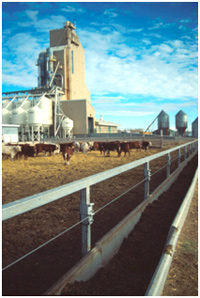
A common environmental footprint concern raised during beef production is the negative impact that intensive feedlot operations have on air quality through the generation of dust and odors. Issues often arise from acreages or towns that reside downwind of feedlots.
Dust can arise from pen surfaces, alleys and roads, and is influenced by humidity, temperature and wind speed. Secondary emissions in the forms of ammonia and odoriferous organic compounds such as amines, sufides, phenols and volatile fatty acids may also occur. Depending on the compound, they can be transported several kilometers from the feedlot.
Balanced feedlot diets that do not exceed animals’ protein requirements reduce nitrous oxide and ammonia emissions.
Long term health consequences associated with exposure to particulate matter from feedlots are largely unknown, but the impacts on individuals suffering from chronic respiratory disease can be severe.
Deposition of ammonia and organics may adversely impact water quality. Ammonia can also contribute to indirect nitrous oxide emissions.
Mitigation
As with nitrous oxide, ammonia emissions from feedlots can be reduced by balancing diets so as not to exceed protein requirements of the animal. Urease inhibitors which inhibit the hydrolysis of urea in urine may also reduce ammonia volatilization but are expensive and may only delay rather than reduce total ammonia emissions.
Fresh bedding, frequent cleaning of pens, shelter belts and wind breaks may all reduce the movement of dust and odors associated with a feedlot. Proper drainage of pens can also prevent the development of the anaerobic conditions that promote such odors. Under arid conditions, sprinklers and water trucks can be used to reduce dust emissions from pen floors, alleys and roads. Many of these practices have the added benefit of improving animal health and housing conditions.
Proper manure management practices can also reduce nuisance odors by incorporating manure immediately after land application. This may also help conserve nutrients for crop growth and increase the organic matter content of soil.
Impact of Beef Cattle on Nutrient Cycles
On grassland

Nutrients are largely cycled within grassland ecosystems without reaching high concentrations or leaving the system. Nutrients in feces and urine are dispersed as cattle move throughout the pasture seeking new forage stands to graze. Fecal pats provide nutrients to insect communities such as dung beetles and the readily available nitrogen in urine is quickly utilized by plants.
For optimal production, cattle require an array of nutrients including protein, carbohydrates, fats, vitamins and minerals. Under grazing conditions, most of these nutrients are acquired directly from forages and cattle require minimal supplementation with trace minerals and salt.
In feedlots
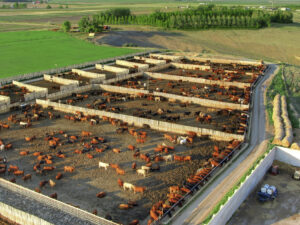
In intensive feedlot systems, feed is transported to the cattle and placed in feed bunks once or twice daily. Diets have a greater energy density as a result of the inclusion of grains increasing the efficiency of beef production. Any nutrients in the feed that are not fully used by cattle are excreted in the manure or as gaseous emissions.
However, in this system some dietary nutrients such as phosphorus exceed requirements, even though diets are not supplemented with this mineral. Because the only component that leaves this system is the cattle when they are shipped to market, other nutrients also accumulate.
Most nutrients are in the manure with the exception of the gaseous emissions described above. Manure is a valuable source of fertilizer and is applied to surrounding farmland, reducing the reliance on chemical fertilizers and increasing the organic matter content of soils. However, due to its high-water content, manure is economical as fertilizer only if it is transported within a radius of 20-to-30 km of the feedlot. Furthermore, manure is usually applied to cropland based on the nitrogen requirements of the crop. This leads to excess application of other nutrients such as phosphorus and potassium, which accumulate in the soil.
To date, there is little evidence that the accumulation of nutrients in cropland adversely impacts the surrounding environment or crop production. This is likely because much of the phosphorus is in an insoluble form. In regions where livestock production systems are more intensive than in Canada, such as Denmark and the Netherlands, the long-term impacts of using livestock manure as fertilizer has become an important issue.
Areas adjacent to intensive feedlot operations need to implement rotational cropping systems or increase manure transport distances to slow the rate of nutrient accumulation in soils.
Impact of Beef Cattle on Water Use and Quality
Canada’s beef industry has dramatically reduced its water footprint over the past several decades, and that trend is expected to continue, according to a study published in 2017. The amount of water required to produce one kilogram of Canadian beef decreased by 17% from 1981 to 2011, due largely to enhanced efficiency in how feed crops for beef cattle are produced, as well as enhanced efficiency in raising beef cattle and producing more beef per animal.
Specifically, the study found that the blue water (surface and groundwater) footprint of Canadian beef in 1981 was 577 L/kg boneless weight at slaughter and in 2011 it was 459 L/kg live boneless weight at slaughter. That’s a 20 percent decline over the 30-year period.
When green water (rain water) was added to the equation, the study found the overall water footprint of Canadian beef in 1981 was 9,625 L/kg live weight at slaughter and in 2011 was 7,989 L/kg live weight at slaughter (respectively 19,301 L/kg and 15,944 L/kg boneless weight). The key focus is water intensity – over the 30-year period the amount of beef produced per unit of water was a lot more and, therefore, water was being used much more efficiently.
The majority of water used in beef production is for crop production. The large variation in previous estimates reflect differences in the assumptions in water use prediction models, such as the inclusion of natural rain fall, wastage during irrigation, and the degree to which water recycling is considered (e.g., irrigation from catch basins).
Water plays a critical role in beef cattle production. Many of Canada’s largest feedlots depend on irrigation water during arid periods. The impact of climate change on water availability in these areas remains unknown, but many models predict an increase in rainfall in the prairie regions where the majority of beef cattle production occurs.
It’s important to note that water is a resource that cycles. The water that is used in beef production does not disappear; eventually the water will cycle back through the system to be used again. Also, beef production activities support a healthy and functional water cycle. For example, raising cattle on healthy pasture, ensures the ecosystem maintains its important water filtration function.
Cattle can also contribute to the conservation of wetlands as these surface waters are not drained as they are for cropping systems. Many of these areas serve as important habitats for aquatic birds and mammals.
Pathogens
Beef cattle can carry protozoa (e.g., Giardia, Cryptosporidium) and bacteria (e.g., Escherichia coli O157, Campylobacter) that cause disease in humans. Water can serve as a vector for these microbes and steps are commonly taken to reduce the risk of manure coming in direct contact with surface water.
Not all microbes shed by beef cattle cause disease in humans. Some strains are adept at persisting in cattle but not in humans.
Modern feedlots are designed with slopped pens and ditches that drain into catch basins with a capacity to hold the precipitation from an extremely intense 24-hour storm. This prevents water from the feedlot directly entering surface streams and creeks. The number of pathogens in this water decreases with time and water from catch basins is used in feed crop production. Use of this water to irrigate vegetable crops that are not cooked prior to consumption should be avoided.
Sensitive riparian areas along streams and rivers are often fenced or lined with buffer strips to reduce the access of cattle to surface water whereas the access of cattle to irrigation canals is restricted. Completely limiting the access of cattle to surface water on grazing lands is impractical and cattle can defecate while drinking and crossing streams. Likewise, wild ruminants (deer, moose) aquatic mammals (beavers, musk rats) and birds (geese, ducks) which can also carry human pathogens, occupy this ecosystem and defecate in the surrounding water. Consequently, when a pathogen does cause disease, its true point of origin is often difficult to determine. The majority of the risk associated with acquiring pathogens can be eliminated by filtering or treating surface water prior to consumption.
Productivity Enhancing Technologies and the Environment
Productivity enhancing technologies (PETs) and growth promotants allow feedlots and producers to raise more beef in a shorter amount of time, with less feed and a smaller environmental impact. A study done on the improvement of cattle performance with conventional PETs, such as implants or feed additives, showed that replacing them with “natural” additives would:
- increase both the land and water required to produce a kg of beef from steers and heifers by 7.9% and 10.5%, respectively;
- increase greenhouse gas emissions in steers and heifers by 5.8% and 6.7%, and;
- increase ammonia emissions by 4.3% and 6.7%, respectively.
Not using implants to produce a kg of beef was also found to increase:
- land and water by 14.6 and 19.5%,
- GHG emissions by 10.5% and 15.8%, and
- ammonia emissions by 3.4% and 11.0% for heifers and steers, respectively.
Additionally, studies have been conducted to determine whether synthetic hormones used in beef production have negative impacts on soil and water when excreted. According to the findings, residues of synthetic hormones like testosterone propionate and trenbolone acetate (TBA) or Melengestrol Acetate (MGA) are discovered in very small amounts of feedlot manure, break down quickly and are extremely unlikely to penetrate surface water, catch basins, or agricultural soils. Additionally, it was discovered that ractopamine residues can be effectively handled by stockpiling manure or composting. The studies found no trace of TBA, MGA or ractopamine in groundwater.
Overall, growth promotants offer significant production advantages that, in turn, help the environment. And their residues pose minimal risk to the environment.
Beef Cattle Production in a Larger Context
Indirectly, the environmental footprint of beef is a reflection of mankind’s demand for high quality protein. In North America, grains represent a significant proportion of the diets of feedlot cattle and contribute to the efficiency of this production system. Even in this case, grains are often initially grown for more value-added markets (e.g., brewing, distilleries, flour), and only end up as feed after they fail to make the grade for human consumption. In fact, 86% of global livestock feed is composed of materials not eaten by humans.
By 2050, as the human population is expected to reach 9.7 billion and the average household income continues to rise, meat consumption is predicted to double. Consequently, it is important that environmental footprints are assessed from the standpoint of the efficiencies of meat production or expressed on impact per kg of meat produced.
Livestock production systems are complex and improvements in one area of production may lead to deficiencies or degradation in other areas. Presently, the economic conditions are favorable for the production of beef from grain in many regions of the world, largely because of the availability of inexpensive fossil fuels. As the price of fossil fuels increases, beef production may revert entirely to relying on what ruminants do best – the conversion of forages into high quality protein.
It is important to keep in mind as one drives through the countryside and sees the fields of hay and hills of native pasture, that ruminants are the only livestock that can effectively convert this biomass into high-quality protein for human consumption. Land that is often too hilly, rocky, or steep to be efficiently used for growing crops or building infrastructure is able, not only provide a high-quality protein source, but also to preserve habitat for wildlife and many endangered species as well as to store carbon.
Environmental Stewardship by Cattle Producers
Cattle producers utilize many grazing management techniques, participate in training and follow sound and practical research to enhance land use, conservation and resource management. Other tools may include cross-fencing, intensive rotational grazing, pasture or rangeland assessment, and fragile lands left in natural grassland or re-seeded to tame grass and forages. In addition, many beef cattle operations and feedyards have completed an Environmental Farm Plan to manage potential risk and undertake many practices beneficial to their local ecosystem, in addition to meeting provincial regulations on confined feeding operations.
The Verified Beef Production Plus (VBP+) program may assist with self-evaluation on important aspects. You can find more information in the Environmental Stewardship Producer Reference Manual.
The Canadian Roundtable for Sustainable Beef (CRSB) Certified Sustainable Beef Framework Guiding Documents can also assist in advancing sustainable beef production.
Videos About Canadian Beef and the Environment
- References
-
1. Legesse, G., Cordeiro, M.R.C., Ominski, K.H., Beauchemin, K.A., Kroebel, R., McGeough, E.J., Pogue, S., and McAllister, T.A. 2018. Water use intensity of Canadian beef production in 1981 as compared to 2011. Science of the total environment. Vol. 619-620 1030-1039. Available here.
2. Legesses, G., Beauchemin, K.A., Ominski, K.H., McGeough, E.J., Kroebel, R., MacDonald, D., Little, S.M., and McAllister, T.A. 2015. Greenhouse gas emissions of Canadian beef production in 1981 as compared with 2011. 56(3): 153-168. 2015. Available here.
3. Legesse, G., Kroebel, R., Alemu, A.W., Ominski, K. H., Mcgeough, E. J., Beauchemin, K. A., Chai, L., Bittman, S., and McAllister, T. A. 2018. Effect of changes in management practices and animal performance on ammonia emissions from Canadian beef production in 1981 as compared with 2011. 98 (4): 833-844. 2018. Available here.
Feedback
Feedback and questions on the content of this page are welcome. Please e-mail us at info@beefresearch.ca.
Acknowledgments
Thanks to Dr. Tim McAllister, Agriculture and Agri-Food Canada principal research scientist, and Dr. Kim Ominski, University of Manitoba professor, for contributing their time and expertise to reviewing this page.
This content was last reviewed December 2023.

